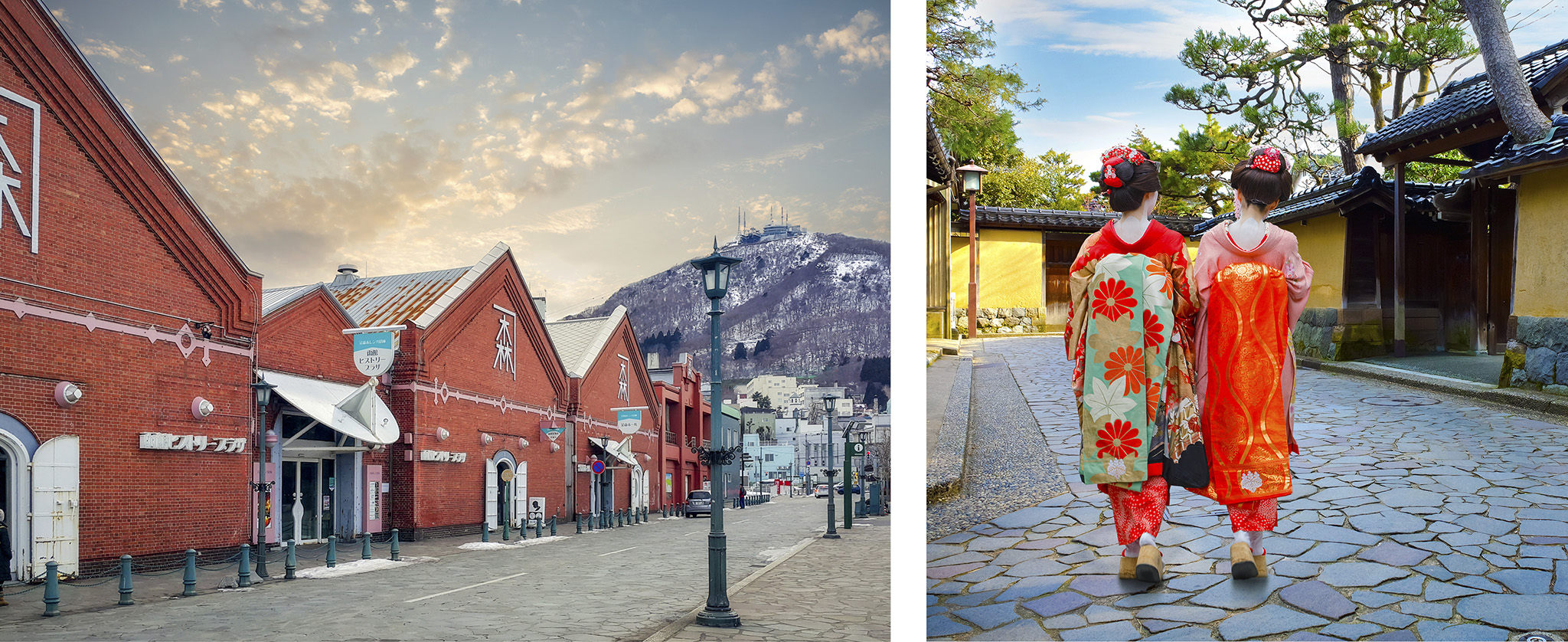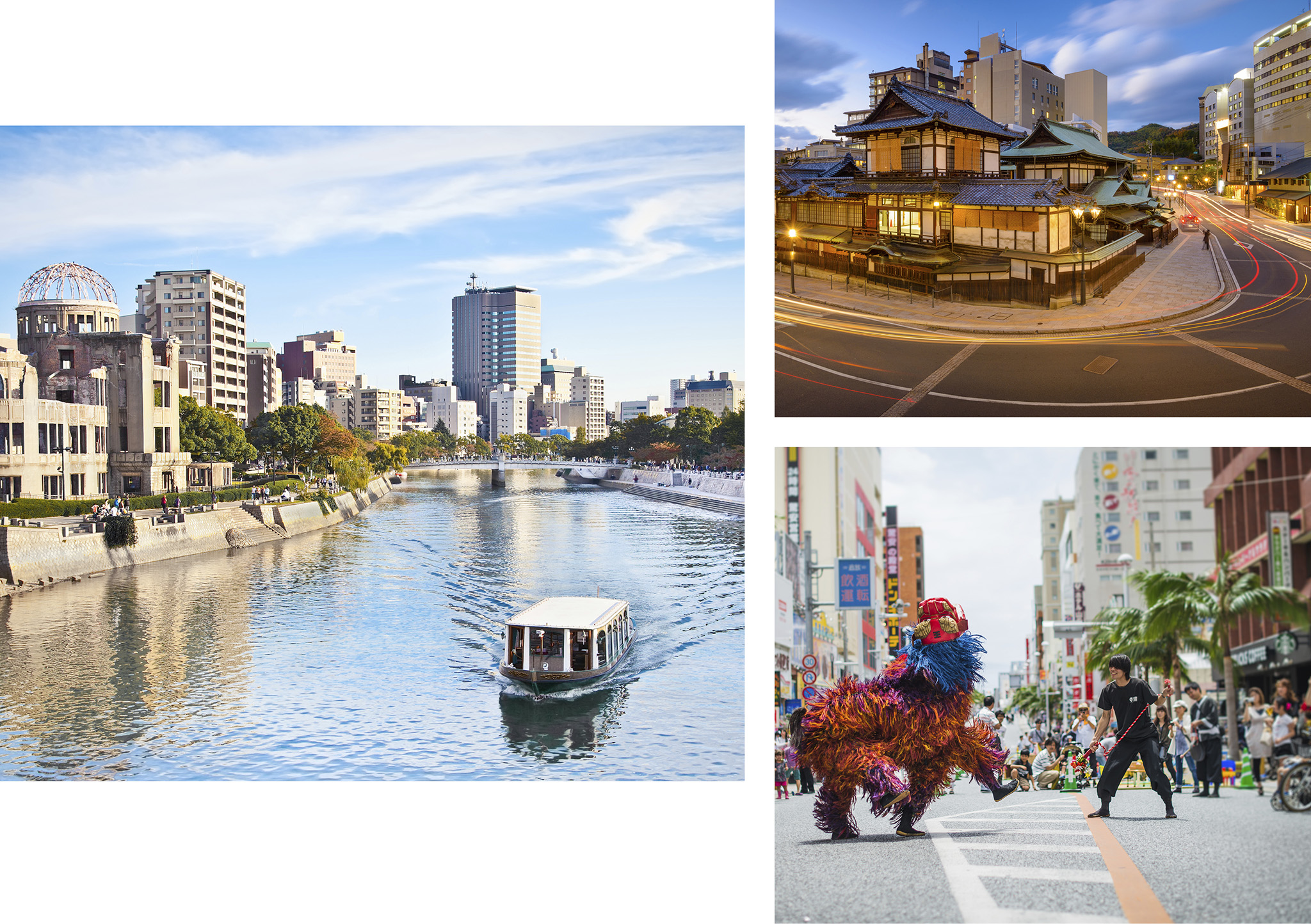都市の景観
Cityscapes
Japan’s dynamic metropolises
Encapsulating the country’s contrasts, Japan’s stimulating cities marry tradition and modernity while also carving out their own unique local character.

D Clockwise from above: Shibuya Crossing is one of Tokyo’s most famous sights; Yokohama has long been a center of shipping and trade; Osaka Castle sits at the heart of the city.
Be More Japan cityscapes
Kyoto
Kyoto is only Japan’s ninth most populated city, but in terms of culture and tourism it’s up there with Tokyo. The city offers many ways to experience traditional Japan: relax at a tea ceremony, try zazen meditation, stay at a ryokan inn, or maybe even enjoy a night of geisha entertainment.
the big five
Traveling to Japan’s most populous cities will fully immerse you in Japanese life, providing the perfect introduction to the country’s culture.
Tokyo
The capital since 1868, Tokyo is Japan’s most densely populated city, with over 9 million people living in its core 23 wards (council districts). Busy central wards like Shinjuku and Shibuya have all the neon, high-rises, and crowds you’d expect, but you can find a different side of Tokyo life in the city’s classical gardens, historic temples, quiet riverbanks, and traditional neighborhoods like Shibamata, Yanaka, and Nezu.
Yokohama
As part of Greater Tokyo, Yokohama in many ways feels like an extension of the capital—but the 3.5 million people living there would be quick to call out some differences. The city has a vibrant Chinatown, for one thing, and a lively bay area that splices modern entertainment complexes with Western-style architecture that dates back to the end of Japan’s self-isolation in the mid-1800s.
Nagoya
Just over 185 miles (300 km) west of Yokohama, Nagoya gets overlooked by many travelers, but with 2.2 million residents, the city is a major economic player—it’s the birthplace of Toyota, among other things. Nagoyans, however, take more pride in their food than business savvy: miso, tebasaki (peppery deep-fried chicken wings), and miso katsu (breaded pork cutlets with a miso sauce) are just some of the delicious local specialities.
Osaka
Moving west again from Nagoya, the 2.7 million people in Osaka are defiantly different—with a reputation for being more direct and outgoing than any other Japanese—and their city reflects that. Dazzling downtown Dotonbori has more neon and hustle than anywhere in Tokyo.
Sapporo
The capital of Hokkaido in Japan’s north, Sapporo is the most distinctive of the big five. Settled by the Japanese in the latter half of the 1800s, the relatively new city incorporated—unusually for Japan—a grid system that makes it a very easy, uncluttered city to get around. It also stands out for its snow. In winter, Sapporo gets a whopping 20 ft (6 m) of it annually, along with temperatures that can dip as low as 5ºF (–15ºC).
Beyond the big cities
Beyond the sprawling mass of metropolises like Tokyo and Osaka, Japan’s smaller cities offer very different urban experiences. More mellow and less densely packed, they’re full of local flavor and history.
Hakodate
Located at the southern tip of Hokkaido, Hakodate’s Motomachi and port districts are home to old red-brick warehouses, churches, and other Western architecture that serve as a reminder of European influences on Hokkaido’s early development in the late 1800s. The city’s fishing fleet, meanwhile, lands some of Japan’s finest crabs, sea urchins, and other seafood, which you can eat fresh at the morning market. Don’t miss the most famous Hakodate sight—the night view of the city from the observation deck atop 1,096-ft (334-m) Mount Hakodate.

D Left to right: Hakodate’s historic warehouses have today been turned into shops; walking through Kanazawa’s streets is like stepping back into the past.
urban population
Over 90 percent of Japan’s population lives in urban areas.
Kanazawa
On the Sea of Japan coast on Honshu, Kanazawa is often referred to as “Little Kyoto.” Known for its gourmet seafood, the city is connected to Tokyo, Osaka, and Kyoto by direct train, but still doesn’t get huge numbers of tourists. In the Edo era, the city rose to prominence under the Maeda clan as the center of the Kaga region, and just as Kyoto is dotted with remnants of its past, so too is Kanazawa. The preserved Higashi Chaya geisha district, Nagamachi samurai quarter, and serene Kenroku-en gardens are just a handful of its treasures.
Hiroshima
On the far west of Honshu, Hiroshima is one of Japan’s best-known cities because of the tragic events that occurred on August 6, 1945, when the US Air Force’s Enola Gay bomber dropped an atomic bomb into the heart of the city, killing tens of thousands of Hiroshimans in a split second. Moving memorials to the tragedy dot the center of modern-day Hiroshima, but they don’t overshadow it—the city itself has a bubbly nightlife and is within easy reach of Miyajima, the island that’s home to Itsukushima Shrine and its sublime “floating” torii gateway.

D Clockwise from left: Hiroshima’s modern architecture sits alongside memorials to the city’s tragic past; Matsuyama’s Dogo Onsen Honkan bathhouse is a Japanese icon; Naha comes alive at festival time.
Matsuyama
Located on Shikoku, the smallest of Japan’s four main islands, Matsuyama is a fine example of a city that balances past and present. The largest and most cosmopolitan of Shikoku’s cities, it has a skyline dominated by a hilltop castle, and its streets still employ a network of rickety old trams. In its Dogo Onsen area, Matsuyama also has one of the most celebrated bathhouses in Japan, the creaking Dogo Onsen Honkan, which has been both a key location in renowned novelist Natsume Soseki’s book Botchan and the inspiration for the bathhouse in Studio Ghibli’s Oscar-winning animated movie Spirited Away.
Naha
Way down in Okinawa, Naha has a very different feel than other Japanese cities. Warm to hot temperatures year-round, palm trees, and a relative lack of high-rises have seen to that, while there are also influences from the US military presence and from Ryukyu, an independent kingdom that included Okinawa until it was annexed by Japan in the 1870s. Apart from the main entertainment area, Naha has a laid-back island vibe, and it makes a great jumping-off point to explore the stunning Okinawan island chains.
